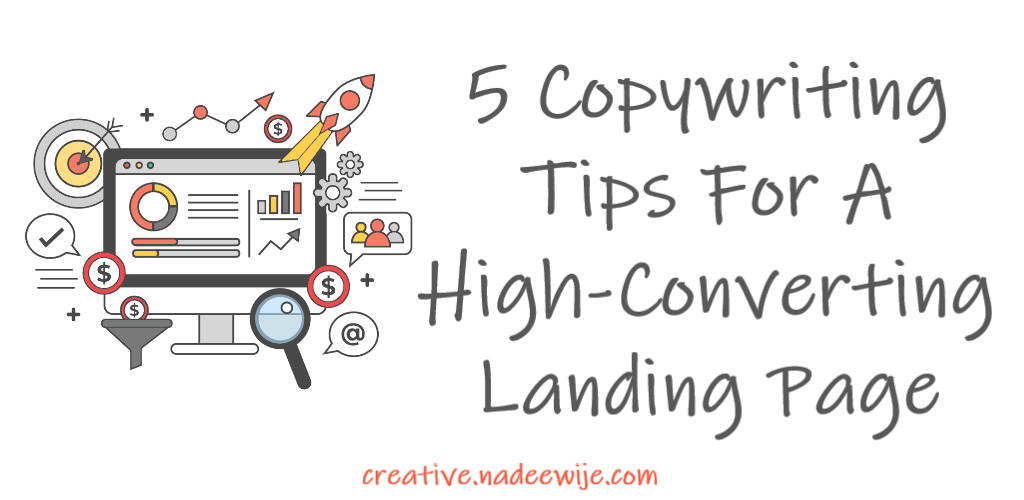Your landing page is like an online brochure. It introduces your company, products or services, and informs prospects of the benefits.
It needs to sell, but it shouldn’t be salesy. No one likes that!
So, how do you sell without being salesy? Empathy.
Use empathy. You need to strike the right balance between being persuasive and engaging. Don’t manipulate. Don’t hard sell. Don’t be aggressive. Instead, persuade with compassion.
Here are some copywriting tips to help you achieve this.

Tip #1: Do your research first
By now, you already know who your target audience is and you’ve probably done some market research. But, that’s not enough. You need to dig deeper.
You need to find out your ideal customers’ values, desires, goals, interests; what they like and don’t like about your competitors’ products or services; the key features and benefits that matter to them.
You’ll also need to observe how they behave and communicate ideas. For example, how they interact in communities on forums, social media.
Research is very important because you are writing for your ideal customer not for yourself. What you believe in doesn’t matter. Your opinions don’t matter. You don’t know what’s best, your ideal customers do.
Even if you match the persona of your ideal prospects, you may not relate to them because you’re on the other side of the fence.
You need to put yourself in their shoes and see things from their perspective. That’s the goal of your research.
Tip #2: Focus on one big idea – your USP
We can only concentrate on one thing at a time. Similarly, your prospects find it easier to focus on one idea at a time.
Your prospects will find it easier to differentiate you from competitors with one big idea. So highlight your USP in the main title and the optional subtitle. Then use the headings, subheadings and body to build up on it.
Use the benefits and features of your product or service to build up on your USP. You can be creative with the wording but use a voice your ideal customer can relate to.
Here’s an example from shopify’s home page:
main title: “Build an online business—no matter what business you’re in”
heading #1: “Bring your business online”
heading #2: “With you wherever you’re going”
subheading #2.1: “Sell everywhere”
subheading #2.2: “Market your business”
subheading #2.3: “Manage everything”
heading #3: “Get the help you need, every step of the way”

Tip #3: Write like how your ideal customers speak
Use the language your prospects use – the slang and technical jargon. Match their tone – formal, informal, humorous, enthusiastic. Highlight the keywords they use when talking about their pain points and the ideal solution to their problem.
Doing this will make you sound like someone who’s part of their community – someone who can relate to them and understand their problems. It will also help you establish authority.
Here’s an example: Accenture’s Supply chain and operation services landing page

Tip #4: Use “you”, “your”, “yours”
Your landing is like your salesperson working 24/7. Every visitor has a one-on-one interaction with your website. So write as if you’re speaking to only one person.
Using “you” will let them know that you’re directly speaking to them, like how I’m directly speaking to you.
As the saying goes: if you’re speaking to everyone, you’re speaking to no one.
Tip #5: Craft a compelling CTA
Use action-oriented words to compel your prospects to act. Keep it short, but long enough to communicate the benefits and reduced risks. Make it personalized as well.
Here are some examples:

Try to stick with one compelling CTA because it makes it easier for your prospects to decide what to do next. If you need to have more than one CTAs, use different colors and text sizes to contrast between them. Also use A/B testing to see if there’s a drop in conversion rates.
You can repeat your call to action several times through out your landing page but stick with a uniform text.
Too many CTAs or variations will cause decision fatigue. More CTAs results in lower conversion rates, and vice versa.
Bonus Tip: Be clear and concise
Get straight to the point. Don’t waste your reader’s time beating around the bush.
For example, instead of this:
“Our team has already been recognized by market leaders and we are setting the trend for industry standards.”
Use this:
“Our team is recognized by market leaders as industry trend setters.”
Summing Up…
- Do your research first and put yourself in your prospects’ shoes.
- Focus on one big idea and build up on it with headings and content.
- Write like how your prospects speak to form a connection.
- Use “you”, “your”, “yours” to sound like you’re speaking to the reader directly.
- Add a short CTA with an action-oriented verb that compels.
- Be clear and concise; get straight to the point.